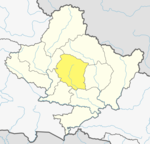Lekhnath
Population
Total population of Lekhnath was 71,434 per 2011 census. Composition of the population was 86% Hindu, 8% Buddhist and 6% others. According to another statistics by the Population Census (C), Lekhnath has seen population changes from 30,107 as of 22 June 1991 contrasted to 41,369 (28 May 2001 per Population Census (Cf)) and 59,498 (22 June 2011 per Population Census (Cf)).
Etymology
Lekhnath, or literally meaning novelist in Nepali language, was named after the famous Nepali poet Lekhnath Paudyal (1885–1966), who was born at Arghaun Archale, or ward No.6 (before the merger) of Lekhnath Municipality. The city was also entitled as the garden city of seven lakes.
Geology
Those seven lakes are Begnas, Rupa, Khaste, Depang, Maidi, Neureni and Gunde. Except Begnas and Rupa most of the other lakes are little known to the outsiders.

Hiking routes
Lekhnath possesses many terrains and mountain view sites. It is growing into a popular destination for hikers because of many beautiful routes through the hills with views of multiple lakes and majestic himalayas at the same time. Lekhanth is the place from where you can catch the view of whole Annapurna range including Machhapuchhre and Dhaulagiri.
Gagangaunda, Shishuwa, Lekhnath chok, Janatako Chautara, Satmuhane, Sajhabazaar, Budhibazar, Dhungepatan, Khudi, Sainik, Talchok are some big and notable places of Lekhnath.
Media
To promote local culture Lekhnath has one FM radio station Radio Lekhnath 106.6 MHz Which is a Community radio Station. To update Lekhnath dwellers and diasporas websites Cityof7lakes.com, Lekhnathcity.com and Lekhnath.com are created.
Footnotes
Notes
- ^ Old website is not maintained anymore.
- ^ The linked page shows a map and two tables. To find data for the location you search, go to the lower part of the page and in the "Major cities" table, select the location you search on the left column; then the second table, "Cities & Urban Municipalities" will show the population statistics as well as the status of the location you selected (city/municipality). You will find a red square marking the location the statistics point to.
References
- ^ "lekhnath munipality government". Retrieved 10 October 2018.
- ^ "Nepal Census 2001". Nepal's Village Development Committees. Digital Himalaya. Archived from the original on 12 October 2008. Retrieved 30 September 2008.
- ^ Brinkhoff, Thomas. "City Population > Cities & Urban Municipalities". Central Bureau of Statistics Nepal (data). Retrieved October 12, 2018.
- ^ "Seven Vanishing Lakes of Lekhnath". Ekantipur.com. 2 April 2010. Archived from the original on 27 July 2014. Retrieved 26 July 2014.
- ^ "Cityof7lakes.com" (in Nepali). Archived from the original on 7 September 2018. Retrieved 10 October 2018.
- ^ "Lekhnathcity.com" (in Nepali). Archived from the original on 26 June 2017. Retrieved 10 October 2018.
- ^ "Lekhnath.com". Archived from the original on 27 August 2018. Retrieved 10 October 2018.
